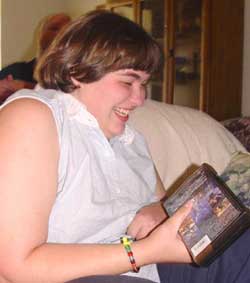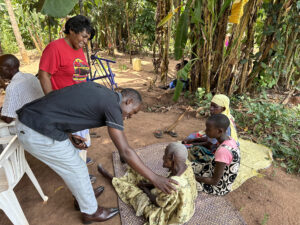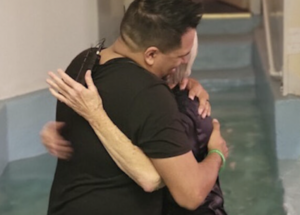
MIAMI (BP)–On Christmas Eve 1995, the entire Satterwhite family gathered at 14-year-old Amber’s bedside in a South Carolina hospital. A noisy respirator delivering air to her lungs, a feeding tube in her nose and the earnest prayers of her family were the only signs of life.
Amber’s 11-year-old brother, Dean, had roamed the hallways of the intensive care unit, crying and upset, earlier in the evening. He had been told the inevitable. Amber would not wake up.
Gone were the days when he and Amber and their 16-year-old sister Jennifer would sit in front of the tree on Christmas morning, tearing apart their presents. Gone was the sweet innocence of a pesky brother’s adoration of his energetic sibling.
Heartbroken, Dean wandered until he found Joy, a hospital volunteer who later visited Amber’s room. In exchange for his misery, Joy prayed with the devastated boy and gave him a box of candy and a crisp $20 bill before guiding him back to his sister’s bedside.
Searching the corridor minutes later to thank the woman and return the money, Dean’s mother, Melody, said she and the hospital nurses couldn’t find any evidence of volunteers who worked that late at night.
There wasn’t a “Joy” to be found on anybody’s schedule either.
“I know it sounds weird, but I tell you, that was our angel,” Melody Satterwhite told the Florida Baptist Witness in an interview at the Satterwhite home in Miami. “Each time we were really down, there was somebody who was here for us.”
“Joy” also had been there when Ron Satterwhite, Amber’s father, cried out to God one night in the hospital’s chapel. Wrestling with a decision doctors said must be made about Amber’s care, Ron encountered the aide who told him about a doctor who ultimately helped the Satterwhites get the rehabilitation their daughter needed.
Whether or not to try rehabilitation wasn’t the most critical decision the Satterwhites had faced during that time, however. What was at stake was whether they should continue to hope that their 14-year-old daughter could ever awaken from what doctors had called a “persistent vegetative state.”
AMBER’S COLLAPSE
Fourteen-year-old Amber had been what is termed a “brittle” diabetic since she was 5. An otherwise healthy and “bright” teenager, she was in the eighth grade when she experienced a seizure due to low blood sugar.
It was late at night, Nov. 2, 1995, and Jennifer Satterwhite awakened her mother after realizing her younger sister was in the throes of a seizure.
“Of course, we knew what to do,” Melody said. “I got the emergency kit, my [other] daughter called 911 and I gave her the shot.” What happened next surprised the family. Despite two shots designed to bring her blood sugars up, Amber continued to seize until she finally slipped into a deep coma more than four hours later.
While her husband stayed home in Batesburg-Leesburg, S.C., with the other children, Melody had traveled to the small country hospital nearly 40 miles away to be with Amber.
“We thought, ‘We’ve gone through this before and everything is going to be okay,'” Melody said. “Well, this was not okay. This was really bad.”
Within hours, the hospital workers had intubated and prepared Amber for travel to a larger hospital in Columbia, S.C. It was determined there that she had an anoxic brain injury caused by a lack of oxygen to the brain as a result of the seizures.
Holding on to hope that Amber would “wake up” sometime within the next 24 hours, Satterwhite said the family was shocked when the hours crept by and there was no change.
“At that point, it was really pretty bad,” Melody said. “They told us to go ahead and pull the plug and donate her organs. Every day it kept getting worse and there was no response. Nothing.”
Melody, whose husband Ron was pastor at Hulon Baptist Church in Batesburg-Leesville, S.C., at the time, said though they had been told to prepare for the worst, she and her husband did not want to be forced into a decision.
“We were not going to turn anything off,” she said. “Of course, we were devastated, but we were at the point where we didn’t know what was going to happen and we were just hoping and praying that she would just wake up. We just knew.”
At one point, Melody said she remembered telling a neurologist hopefully that Amber’s eyes were half open.
“He looked me in the eye and said, ‘Dead people have their eyes open, too,'” Melody recalled.
Then came the struggle for what to do next. The family was already considered a nuisance. They played music for Amber in intensive care. Her mother rubbed a brush on her hands, hoping the sensation would stimulate her senses and trigger her to consciousness. Both parents believed she should be getting constant stimulation and therapy.
After wrangling with the doctors and insurance companies, Melody said one social worker suggested they send Amber up north to a nursing home facility where she would be dead within six months. That way they could “go home” and “get on” with their lives.
Another doctor scoffed at the notion of rehabilitation and told Melody, “[Amber] is in a vegetative state. There is no hope for her — no help for her in a rehab hospital. There is no way.”
Finally, one lone doctor agreed to evaluate Amber again. The doctor determined she was in a “low-level coma” and that therapy would help.
The insurance company finally agreed with Amber’s placement in a rehabilitation hospital and the next months proved to be both encouraging and frustrating for the family.
Just a short while after arriving at the rehab center, Amber aspirated on her feeding tube, succumbing to aspiration pneumonia. She had to return to the hospital. Completely dehydrated and ravaged by fevers, Amber almost died then, and the family planned her funeral.
“Ron and I prayed, ‘Lord, we’re ready to give her to you. She’s going home, and if that is to be, you’ll take her home, and if not, we’ll do everything we can,'” Melody recounted.
Within just a short time, however, Amber weathered the infection and the family, finally at peace about Amber’s condition, had no way of knowing her road to recovery had begun in earnest.
COMATOSE REHABILITATION
After months of listening to Amber scream with pain during intensive therapies and watching tears fall from her eyes while she sat propped up in a wheelchair in the hospital chapel listening to hymns — Melody said it was frustrating to realize Amber was still in a coma and still had a “far-away look” in the blank stare fixed on her face.
Always hopeful despite being continually told Amber would never improve, Melody said she disregarded the disapproving looks she received and continued to “push the envelope” in trying to spark Amber’s memory.
Melody said it was an old movie, “Weekend at Bernie’s,” which inspired her to take Amber out of her wheelchair and stand behind her and walk her “like a doll,” to prop her up and help her go through the motion of standing upright.
“I did it because I just knew that she was going to do it. I pushed. They told us she would never walk, but I didn’t listen to them,” Melody said. “I remember saying, ‘She’s gonna walk.'”
During those long months in rehabilitation when Amber showed little change and the neurologists had long since given up, her mother said she remained optimistic that “Amber was still there” and knew what was going on.
“A neurologist is looking medically. I am looking at the Lord and I knew that God would do something and we just never gave up,” Melody said. “It was hard and we pushed.”
But no matter how hard they worked, it appeared Amber would not respond. And like most patients in a persistent vegetative state, she received nutrition and hydration through a feeding tube — which Melody said healthcare workers insisted could “never” be removed. They had predicted Amber could not swallow and therefore permitted no therapy that might cause her to choke.
Understanding his daughter’s penchant for sweets, Ron Satterwhite wasn’t prepared to give in so easily. Armed with a grape Nehi soda, he dipped his finger into the drink and put it in Amber’s mouth one day and she began to suck.
To the chagrin of the hospital’s staff, Amber slowly learned to eat again by swallowing a small amount of pudding her father placed on the side of her mouth.
Sitting strapped in a rocking chair, Amber also surprised hospital staff and her parents one day when she reached out her foot and started pushing herself to and fro.
“She was still in a coma at that point,” Melody said. On another occasion, Amber followed a nurse across the room with her eyes. “Amber is here. Amber is waking up,” Melody recalled the nurse saying.
OXYGEN THERAPY
After nearly six months at the rehab hospital, Melody said the Satterwhites were told the doctors had done everything they could and the insurance company said, in so many words, “She’s got to go home now.”
Still unwilling to accept Amber’s comatose state as permanent, Melody said she packed Amber in the family’s vehicle and drove her to Fort Lauderdale, where physician, Richard Neubauer, used hyperbaric oxygen therapy in order to stimulate healing in Amber’s brain.
“Putting her in those chambers was a nightmare,” Melody reflected, but after nearly half of what would become 95 treatments — one hour, two times a day, six days a week — Amber finally calmed down and even grinned while ensconced in the huge metal machine.
This transformation is documented on a home video. She also began to walk on her own, to smile and laugh, to dance to “Flintstones” music with Jennifer. On returning home after four months in Florida, Amber paused to study the pictures on the wall. A tentative smile lights her narrow face. Melody says, in the video, “Oh, Ron, she can tell it’s her family.”
Speech came later after a visit to a world-renowned doctor in Beverly Hills, Calif., who uses neurofeedback to re-teach speech patterns.
“‘Mama’ was the best word I ever heard, and that was three to four years in the making,” Melody said. “It does take a lot of time. It’s been hard. But if God was going to take her home, He would do it naturally.
“As long as there was hope and as long as there was breath in her life and her body, we were to fight for it,” Melody said, “because God entrusted her to us to do everything that we possibly could to get her through.”
MOVING TO FLORIDA
In 2000 Ron Satterwhite was called to pastor North Palm Baptist Church in Miami. The family had moved to another church about a year after Amber’s collapse when they felt the family’s needs overshadowed Hulon Baptist. They made the move to Miami when the folks at the other South Carolina church were afraid of Amber and, as Melody put it, “didn’t know what to expect.”
Church is inarguably Amber’s favorite place to go.
“I enjoy church,” Amber said at Melody’s prompting.
“If everybody liked to go to church as much as Amber did, we’d have a full church every Sunday,” Ron said. “The reason she likes church is because everybody accepts her there.”
Boisterously joining her father in singing one line of a verse from “How Great Thou Art,” Amber plopped down on the couch with a video she snatched from the bookcase.
“Donny Von, Donny Von,” she croons, then breaks out in loud laughter. Her mother says “Donny Von” was one of the interns Amber got to know at the speech center in California.
During an interview, Amber is temporarily distracted by having to sit on the couch for Melody to put her shoes on and tie them. Within moments, however, she is up and off the couch and heading towards the front door to go to church where she helps with the kids in the nursery and where the youth are uncharacteristically gentle with her.
Melody said in most situations Amber responds like a 3-year-old. Other times, Amber acts like any other 22-year-old. “We can take her to the beach and she sees a good-looking guy and she’s gone after him,” Melody said. “She loves hanging around the teenagers.”
Doctors give the Satterwhites no hope for improvement. At 22, Amber is still a brittle diabetic. Her need for a constant intake of sugar to ward off seizures has caused her to gain weight. She can act aggressively toward her parents and has kicked seven windshields out of the family’s vehicles, Ron said.
But still, Melody said, there is a lot of joy in a child who walks around saying, “I lovely.”
Amber will graduate from a special program at her high school in May. She picks up new words every day. She causes children to laugh and adults to smile at her childish behavior.
“We are privileged to be living with a miracle every day,” Melody said. “God has healed her.”
This Christmas Eve, 19-year-old Dean Satterwhite need not fear Amber won’t awaken. While lying in the fields of Iraq, keeping watch over his Army buddies, Dean can rest knowing God has not yet called Amber home. His parents are watching over their little sheep — even the least of these.
–30–
The Satterwhites, who have shared their story at various churches and special gatherings, can be reached at (305) 494-3895 or, via e-mail, [email protected]. (BP) photos posted in the BP Photo Library at http://www.bpnews.net. Photo titles: AMBER’S JOYS, SMILING DESPITE THE ODDS and BACK THEN.

















